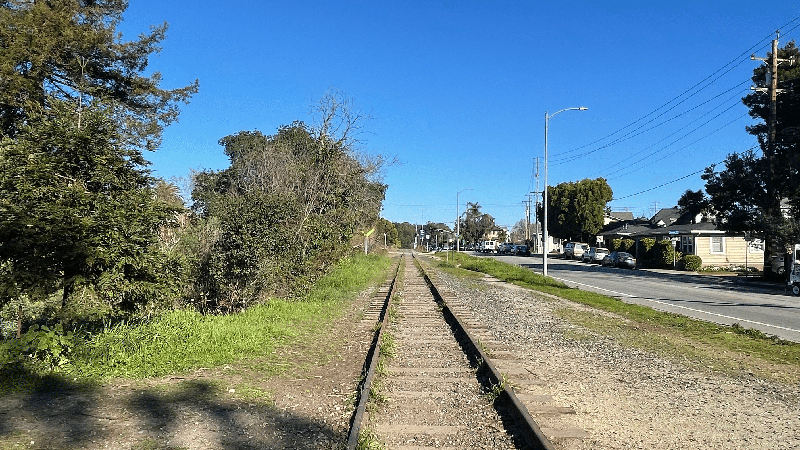
The new money will pay for construction of a trail near this section of Murray Street.
Santa Cruz County Bicycle advocates were thrilled and surprised last week when they learned that the California Transportation Commission (CTC) had granted $115 million to the county to implement a number of bike-transportation projects—including funding needed to complete a section of the Rail Trail between Santa Cruz and Aptos.
Kirsten Liske of Ecology Action, the Santa Cruz nonprofit that has been leading the community on bicycle transportation issues for decades, says the grant award is historic, and will have major consequences.
Liske points out that two unprecedented things happened last week. First: Every application that was submitted to the state for a Santa Cruz County project got funded. That has never happened before. Even though they’ve worked with Caltrans on many grant applications for many years, she says, EA staff never expects to bat 1.000. This year it happened.
Secondly, Liske says, the $103 million that will be used to fund segments of the Rail Trail from the Santa Cruz Harbor to the Seacliff neighborhood in Aptos is the biggest grant CTC’s Active Transportation Program has awarded in its history. “This is transformative,” she says.
The CTC awards include more than $10 million for a number of bicycle projects that EA spearheaded, including some in South County. Several of these will connect schools and neighborhoods to the Rail Trail—serving as “ribs” to the transportation “spine” of the rail corridor.
“What’s transformative is that Aptos will be within easy reach for e-bike commutes to, say, Dominican Hospital, or anything along the Soquel Avenue corridor,” Liske says. “Downtown Santa Cruz is also in range. We already have people commuting on e-bikes from Capitola to the Westside. We certainly will be getting people commuting from Aptos to Santa Cruz.
“Having this a straight, flat, protected bike lane covering so much of the county in our lifetimes [laughs]—and it’s already funded—this is going to enable an amazing increase in bike commuting.”
Liske says more than a decade of work building physical and social bicycle infrastructure set the county up to win the grant money. She points out that in order to be eligible to apply for implementation funds such as were distributed last week, projects must have completed a plan such as an Active Transportation Plan or a Safe Route to School Plan. These plans are required to show that they’ve already won public approval in order to be eligible for the money.
“Our region had very few of these plan 10 years ago,” Liske writes in an email, “and Jeanne LaPage drove Ecology Action to adopt a goal of ensuring that every Monterey Bay community had them.”
In ensuing years, LePage worked with transportation planners, engineers and others at municipalities up and down Monterey Bay. Maps and plans were produced and bike lanes were built. Engagement components such as kids’ bike-safety training and safe-route rides were launched and well attended—the state wants to see that once infrastructure is built, there is a constituency ready to use it.
“It was really innovative and passionate public servants in the various public agencies that made this happen” Liske says.
With this money, 18 miles of the planned 32-mile trail from Davenport to Watsonville is fully funded and slated to be complete by 2025.
In related news, the Santa Cruz County Regional Transportation Commission voted on Dec. 1 to conduct a $7 million preliminary study on the rail component of the Santa Cruz Rail Trail.